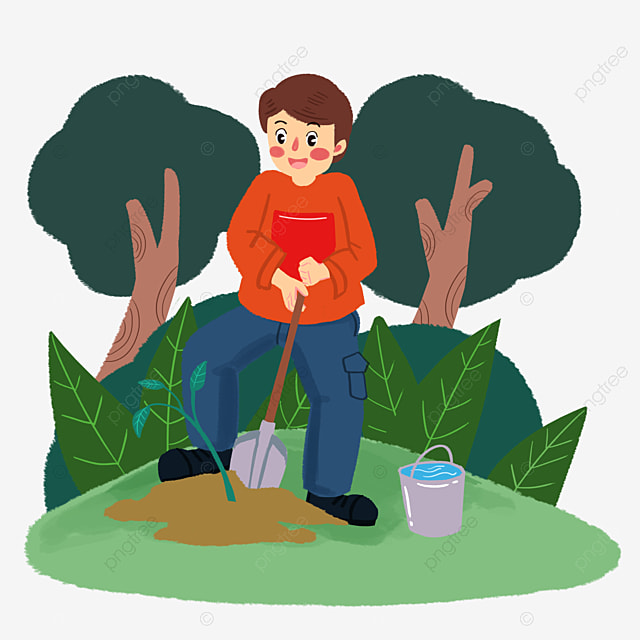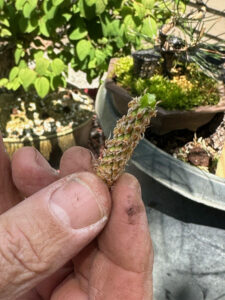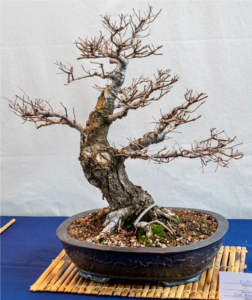
My experiences in Collecting Bonsai
I began collecting trees in 1985 when I visited my parents in northern Michigan. The cost was a major factor in this decision. I brought between 35 – 70 trees home each year. I sold off 90 percent of these to buy tools and pots. I also did urban collecting and development collecting. Development collecting is getting permission to collect on a property that is about to be developed for building. The first folks I collected with knew about these developments and would get us permission to dig trees. We just had to sign waivers of liability. We collected a lot of trees at those sites.
I was always on the lookout for trees. If I saw a tree or bush that looked good for Bonsai and if it looked like they were moving out or remodeling, I would go ask if I could dig up that bush in the front yard. Once in a while, they allowed me too.
The truest opportunities for collecting Bonsai are in the wild. No one does it like Mother Nature. Bent, twisted, deer browsed, buried, trampled, blow away. The trees being collected today are truly amazing. Back in my collecting days there was little info on collecting. One day I stopped at a nursery in Michigan and bought several trees. I explained to the owner, Harold, why I was collecting trees. And he said, “Son, see that land stretching out from over there to over yonder.” As he swept his hand from far left to not so far right. “That is my land, and you can dig up any tree you want. But it will cost you a $1 a tree, because that is what I was paid to plant them.” Turned out it was 10 acres of nursery and 500 of woods. I collected trees from both.
Permission is suggested on unknown land. When I was out digging, I was on occasion asked, “what you are doing?” and I would go through my spiel about Bonsai. Each time I luckily got the same response. “Well, I own everything up to 8 Mile Road. Feel free to dig up whatever you want.” Another time in a far west suburb, we were walking back to our cars. We had big black trash bags full of trees and a shovel over our shoulders. When we got to the truck, there was an officer of the law waiting. He looked at us, and said, “So, what the —- are you two up to?” I looked him straight in the eye and said,” We are with the Save the Trees Foundation, and we have come here to save these trees before they develop this property.” as I shook my bag of trees. Well, he looked at us for a couple minutes, and said,” Get the —- out of here and if I see you again, I am taking you in.” We never went back.
On another occasion in northern Michigan, I was collecting Larch in a bog. Let me tell you, do not do this alone. I stepped on solid looking ground, only to find myself, sinking up to my belly in the blackest muck. Lucky again, I grabbed a branch and dragged it over to me. I got myself onto that branch and shimmied to safety. That was a narrow escape.
I never brought very much with to collect trees. What you need is: Permission to dig, a sharp flat 10” spade, a saw, shears, plastic bags, twine, water, and snacks.
What you are focusing on is the trunk of the tree. You want to study the trunk and the root base. The foliage can be reduced in time. Dig as much of the root as possible. I usually start at the foliage line and dig a trench around the tree and then dig in under. Remove the tree from the ground. I saw or chop out large roots as I dig. For deciduous material knock the soil from the roots, and place in plastic bag. For pines and evergreen keep as much of the soil on the roots as possible. Bag the roots and tie up the bag. Trim the roots on the deciduous trees. We are always trying for a horizontal root system, so trim accordingly. The evergreen and pine should be planted with the old root ball intact. Remember to pot the tree deeper in the pot, to promote good root base development. At the next repotting you will remove that old soil. Also, you should splash a little water into the bag with the trees. Have everything ready to repot when you get home that way you can get right to it.
After collecting you will grow the tree for 2-3 years before repotting. This allows the tree to get strong again so you can do more work on the tree. During this time, you can begin the styling of the tree. Work on branches development. So get out and get yourself a few trees.
Phil Malhiot



